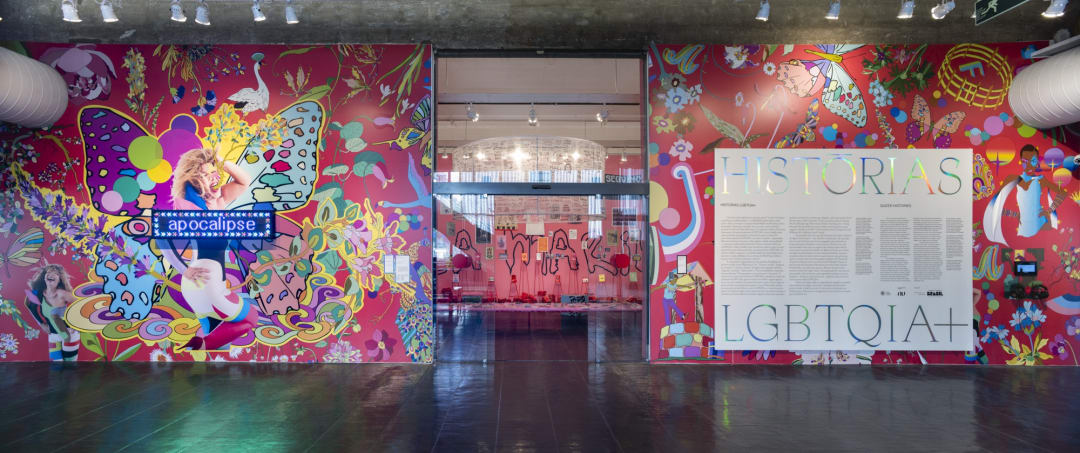The current global landscape for queer and trans people is uneven: acceptance, solidarity, and visibility exist alongside hatred, censorship, and outright legal prohibition in different parts of the world. Thus, on the one hand, greater attention to Lesbian, Gay, Bisexual, Transgender, Queer, Intersex, and Asexual (LGBTQIA+) issues has created increased opportunities for openly queer and trans artists and thinkers. On the other hand, LGBTQIA+ people around the world—impacted differently by race, class, gender, age, nationality—continue to face repression. Within this context, Queer Histories gathers works that thematize queer topics or are made by LGBTQIA+ artists, activists, and researchers. The show celebrates the richness and multiplicity of queer creativity in the visual arts, aligned with MASP’s mission which defines the museum as “diverse, inclusive and plural.”
The exhibition is organized in eight sections. On the first floor gallery are “Biblioteca Cuir,” “Icons and Muses,” “Spaces and Territories,” and “Love and Desire.” On the second sublevel gallery, “Sacred and Profane,” “Abstractions,” and “Ecosexualities and Otherworldly Fantasies.” On the mezzanine level, “Archives.” The majority of artists in Queer Histories are working in the wake of the 1980s onset of the ongoing HIV/AIDS pandemic, a crisis that has powerfully redefined the stakes of artmaking from queer and trans perspectives.
Not every artist in the exhibition identifies as LGBTQIA+; rather the show treats queerness expansively, as a lens that lets us see the world differently. Though some of the artists in the show died of AIDS-related complications (including David Wojnarowicz, Felix Gonzalez-Torres, Leonilson, Martin Wong, Nicolas Moufarrege, Peter Hujar, Rotimi Fani-Kayode, and Tseng Kwong Chi), the exhibition also features contemporary HIV+ artists who are living and thriving (such as D’Angelo Lovell Williams, Kia LaBeija, and Sunil Gupta).
Of special interest across the exhibition is the notion of queering history—either by using fiction and storytelling to invent the histories that have been erased, or by turning to the past to envision new futures. The show thus features artworks that speculatively engage with archives
(as in the work of Mayara Ferrão, who uses artificial intelligence to invent Black lesbian histories) and update canonical works of art to conjure a queer or trans presence (as in the leather-clad, campy version of Tarsila do Amaral’s Abaporu by Rodolpho Parigi, Yasumasa Morimura’s self-portrait in drag as Frida Kahlo, and Lyz Parayzo’s subversion of Lygia Clark’s iconic Bicho sculpture). The juxtaposition of material from the past and the contemporary moment underscores how histories—including art history—function as critical resources for LGBTQIA+ lives.
Queer Histories is curated by Adriano Pedrosa, Artistic Director, and Julia BryanWilson, Curator-at-Large of Modern and Contemporary Art, with the collaboration of André Mesquita, Curator, and the assistance of Leandro Muniz, Assistant Curator, and Teo Teotonio, Curatorial Assistant, all at MASP.
The exhibition is part of MASP’s annual program around Queer Histories in 2024, which includes shows devoted to Francis Bacon (1909-1992), Mário de Andrade (1893-1945), Catherine Opie, Lia D Castro, Leonilson (1957-1993), the Gran Fury and Serigrafistas Queer collectives, the MASP Renner Collection, as well as Video Room projects by Masi Mamani/Bartolina Xixa, Tourmaline, Ventura Profana, Kang Seung Lee, and Manauara Clandestina.
A significant number of loans in Queer Histories come from a special partnership with the Leslie Lohman Museum, New York City, one of the few institutions dedicated to LGBTQIA+ art in the world.

